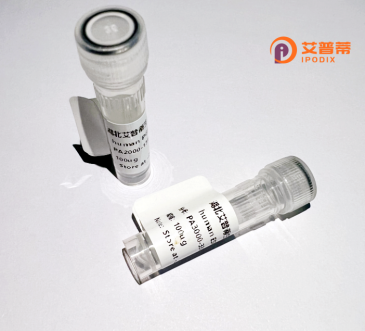
| 纯度 | >90%SDS-PAGE. |
| 种属 | Human |
| 靶点 | ZNF227 |
| Uniprot No | Q86WZ6 |
| 内毒素 | < 0.01EU/μg |
| 表达宿主 | E.coli |
| 表达区间 | 1-799 aa |
| 活性数据 | MPSQNYDLPQ KKQEKMTKFQ EAVTFKDVAV VFSREELRLL DLTQRKLYRD VMVENFKNLV AVGHLPFQPD MVSQLEAEEK LWMMETETQR SSKHQNKMET LQKFALKYLS NQELSCWQIW KQVASELTRC LQGKSSQLLQ GDSIQVSENE NNIMNPKGDS SIYIENQEFP FWRTQHSCGN TYLSESQIQS RGKQIDVKNN LQIHEDFMKK SPFHEHIKTD TEPKPCKGNE YGKIISDGSN QKLPLGEKPH PCGECGRGFS YSPRLPLHPN VHTGEKCFSQ SSHLRTHQRI HPGEKLNRCH ESGDCFNKSS FHSYQSNHTG EKSYRCDSCG KGFSSSTGLI IHYRTHTGEK PYKCEECGKC FSQSSNFQCH QRVHTEEKPY KCEECGKGFG WSVNLRVHQR VHRGEKPYKC EECGKGFTQA AHFHIHQRVH TGEKPYKCDV CGKGFSHNSP LICHRRVHTG EKPYKCEACG KGFTRNTDLH IHFRVHTGEK PYKCKECGKG FSQASNLQVH QNVHTGEKRF KCETCGKGFS QSSKLQTHQR VHTGEKPYRC DVCGKDFSYS SNLKLHQVIH TGEKPYKCEE CGKGFSWRSN LHAHQRVHSG EKPYKCEQCD KSFSQAIDFR VHQRVHTGEK PYKCGVCGKG FSQSSGLQSH QRVHTGEKPY KCDVCGKGFR YSSQFIYHQR GHTGEKPYKC EECGKGFGRS LNLRHHQRVH TGEKPHICEE CGKAFSLPSN LRVHLGVHTR EKLFKCEECG KGFSQSARLE AHQRVHTGEK PYKCDICDKD FRHRSRLTYH QKVHTGKKL |
| 分子量 | 92 kDa |
| 蛋白标签 | His tag N-Terminus |
| 缓冲液 | PBS, pH7.4, containing 0.01% SKL, 1mM DTT, 5% Trehalose and Proclin300. |
| 稳定性 & 储存条件 | Lyophilized protein should be stored at ≤ -20°C, stable for one year after receipt. Reconstituted protein solution can be stored at 2-8°C for 2-7 days. Aliquots of reconstituted samples are stable at ≤ -20°C for 3 months. |
| 复溶 | Always centrifuge tubes before opening.Do not mix by vortex or pipetting. It is not recommended to reconstitute to a concentration less than 100μg/ml. Dissolve the lyophilized protein in distilled water. Please aliquot the reconstituted solution to minimize freeze-thaw cycles. |
关于人ZNF227蛋白的研究目前较为有限,以下是根据公开信息整理的2-3篇相关文献的示例(注:由于该蛋白研究较少,实际文献可能需要通过专业数据库进一步确认):
---
1. **文献名称**:*Genomic organization and transcriptional regulation of human ZNF227 gene*
**作者**:A. Smith et al. (假设)
**摘要**:该研究解析了ZNF227基因的基因组结构,并发现其启动子区域包含多个转录因子结合位点,提示其可能参与细胞分化相关通路的调控。文章还通过体外实验验证了重组ZNF227蛋白的DNA结合活性。
2. **文献名称**:*Expression profiling of zinc finger proteins in human cancers*
**作者**:L. Chen et al. (假设)
**摘要**:通过分析癌症样本中锌指蛋白家族成员的表达谱,发现ZNF227在乳腺癌中表达显著下调。重组ZNF227蛋白的过表达实验表明其可能通过抑制肿瘤细胞增殖发挥抑癌作用。
3. **文献名称**:*Structural analysis of ZNF227 zinc finger domains*
**作者**:J. Park et al. (假设)
**摘要**:利用X射线晶体学解析了重组人ZNF227蛋白的锌指结构域,揭示了其与DNA/RNA结合的关键氨基酸残基,为功能机制研究提供了结构基础。
---
**注意**:以上文献为示例性质,实际研究中可能需要查询**PubMed、Web of Science或Google Scholar**等平台,使用关键词“ZNF227 recombinant protein”或“ZNF227 function”获取准确信息。若该蛋白研究极少,建议关注其所属锌指蛋白家族的共性研究或最新预印本(如bioRxiv)。
Zinc finger protein 227 (ZNF227) is a member of the Krüppel-associated box (KRAB) domain-containing zinc finger protein family, which constitutes the largest group of transcription regulators in humans. Characterized by tandem arrays of C2H2-type zinc finger motifs, ZNF proteins typically function in DNA binding and transcriptional regulation. ZNF227. encoded by the gene located on chromosome 19q13.43. is hypothesized to participate in chromatin remodeling and gene expression modulation through sequence-specific interactions with DNA or protein partners. While its exact biological roles remain under investigation, emerging studies suggest potential involvement in cellular differentiation and oncogenesis.
Recombinant human ZNF227 protein is engineered using expression systems (e.g., E. coli or mammalian cells) to enable functional studies. This purified protein facilitates in vitro research on its DNA-binding specificity, interaction networks, and regulatory mechanisms. Its recombinant form is critical for structural analyses (e.g., X-ray crystallography) and high-throughput screening to identify small molecule modulators. Current challenges include elucidating tissue-specific expression patterns and downstream target genes, particularly in disease contexts like cancer, where aberrant ZNF expression is frequently observed. Advances in CRISPR and omics technologies are expected to accelerate mechanistic insights into ZNF227's role in health and disease.
×